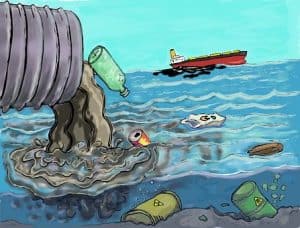[fusion_builder_container hundred_percent=”yes” overflow=”visible”][fusion_builder_row][fusion_builder_column type=”1_1″ background_position=”left top” background_color=”” border_size=”” border_color=”” border_style=”solid” spacing=”yes” background_image=”” background_repeat=”no-repeat” padding=”” margin_top=”0px” margin_bottom=”0px” class=”” id=”” animation_type=”” animation_speed=”0.3″ animation_direction=”left” hide_on_mobile=”no” center_content=”no” min_height=”none”]
Climatic Change
December 1990
Jesse Ausubel’s review (Ausubel, 1982) of our recent joint analysis (Lovins et al., 1982) stimulates us to suggest, in the same friendly spirit, a few respects in which he missed the mark.
In considering how little energy could be used, and how little fossil fuel burned, if people used energy in a way that saved money, we do not feel we were being ‘extremely optimistic’, but rather soberly realistic. Perhaps Ausubel means by ‘optimistic’ something like James Branch Cabell’s remark that “The optimist proclaims we live in the best of all possible worlds; the pessimist fears this is true.” But the word implies that he thinks we are extrapolating unique, best-case results as if they could be achieved everywhere.
Someone not acquainted with the extraordinarily rapid recent progress in technologies for wringing more work from each unit of energy might easily jump to this conclusion. But the empirical cost and performance data which we document in considerable (some would say tedious) detail tell quite the opposite story. Verifying the references will confirm that we have consistently assumed less-than-best-case technologies, slowly and unevenly applied, with robust rather than arguable cost advantages.
This is illustrated by the Saskatchewan Conservation House, a best case which Ausubel apparently assumes we believe will be universally replicated. Since its completion in late 1977, that model house has achieved, as we state, ‘the best heat loss value’ of any house documented up to late 1981: its net space-heating requirement is only 2.8% that of an average 1973 West German dwelling. But we do not assume that German dwellings will ultimately reach this standard (even though they probably could). Rather, we assume the net space-heating requirement for new houses in Germany will eventually fall to nearly twice that of the Saskatchewan Conservation House, and that retrofits will eventually improve old German houses so that they need only nine times as much heat as the Saskatchewan model. (We conservatively assume that apartments need as much heat per square meter as single-family dwellings; in fact they need substantially less because they have a smaller surface-to-volume ratio.) Whether Ausubel believes them or not, the superinsulation costs we cite (which have since fallen in real terms) have been empirically confirmed not just in one house but in thousands of houses, built in several countries, using at least a dozen basic designs. Indeed, many of those houses, by using new and highly cost-effective technologies, have reduced heating requirements to essentially zero, even in severe climates.
Ausubel’s $360+-per-window price quotation for triple-glazing his existing windows shows two things. First, retrofits, though often worthwhile, do generally cost more than building things right the first time: our housing examples show the typical ratio is about five to twenty. (Ausubel decreases that ratio by incorrectly quoting us as saying that a Saskatchewan technique of installing superinsulation while re-siding a frame house costs $34,000; we actually say this is the extra cost beyond the cost of re-siding alone.) Second, careful shopping is vital. Ausubel could, for example, insulate his windows as well as triple glazing at less than a tenth the cost, using two layers of flexible acrylic attached with magnetic tape. Or he could insulate the windows twice that well at a third the cost of triple glazing by using the best available movable insulation. Thus triple glazing, though it may be cheaper than oil, is a much worse buy than many other options he did not know about. This sort of lack of information is one of the barriers to efficient investment which we identified and which must be removed if energy savings are to solve the CO2 problem. Remember, we never said a low-climatic-risk, least-cost energy strategy is easy; only that it is possible, and easier than dealing with the climatic and other consequences of high-energy, economically inefficient futures.
Another economic point should be cleared up. We compare efficiency and renewable investments not only with such conventional long-run marginal sources as synfuels and nuclear power, but also with recent fuel prices. Nearly all the technologies assumed in our German case-study pay back quickly against 1980 German fuel prices. All are absurdly good buys against the oil-replacing future energy sources in which governments are already investing billions of dollars per year. As we show elsewhere (Lovins and Lovins, 1982), virtually all the technologies we assume are also cheaper than coal, even in coal’s best markets (e.g., high-temperature process heat). All are cheaper than any plausible price for deep gas which might be discovered in the future. Thus coal, gas, or other proposed panaceas are unlikely to undercut the cost of the options we discuss – especially the efficiency improvements on which our climatic conclusions rest. Those investments are remarkably indifferent to energy price: many of them cost $0-10/bbl, and few exceed $25/bbl ($4.3/GJ). Such prices will be very hard to beat, no matter how much oil and gas is found.
A detailed analysis by our colleague Florentin Krause (Krause, 1982), who supplied most of the data in our F.R. Germany case-study, confirms this point using German data. Compared to the 1973 housing stock, heat savings of over 95% in new construction cost $2-3/GJ (1980 $), and savings of up to 90% in retrofits (we assumed 80%) cost $5-12/GJ. In contrast, F.R.G. oil heat at 85% efficiency (the 1973 norm was actually 48%) now costs about $13/GJ. Marginal nuclear-electric heating costs $31-40/GJ under very favorable assumptions, including a 210-230%-efficient heat pump with zero maintenance cost and a reactor costing less than empirical values.
It is not true, as Ausubel states, that our analysis compares costs for renewable sources “achievable through economies of scale” with “costs for the new, clumsy, ‘hard’ alternatives; the possibility.., that nuclear plants would similarly become cheaper if many more are built is not included.” On the contrary, we explicitly exclude all renewables not already in or entering commercial service, and do not count putative future savings from mass production. Symmetrically, we do not assume mass production of nuclear plants; but if we did, it would strengthen our conclusions, since empirical nuclear capital costs rise steeply with increased capacity – as shown in the first published supply curves for coal and nuclear plants (Lovins and Lovins, 1982)*.
We did not claim that the soft path is already being implemented everywhere – though its unheralded recent accomplishments in many market economies have been startling, and it has strong support even in such centrally planned economies as Romania and P.R. China. Nor did we suggest that economics should be the sole or even the main basis for public policy, although, at least in energy policy, it is a surprisingly sound guide. Rather, we sought to show that economics is one of the best tools for protecting the climate -not an obstacle to doing so. Ausubel raises an interesting point in Cesare Marchetti’s theory that the evolution of the energy system was driven by scale economies. Unfortunately for the theory, the net economies of scale have actually been going more and more negative for well over a decade. A recent analysis (id.) of empirical data shows that of nearly fifty effects of scale on the economics of energy systems, a few favor large scale, but most penalize it in the overwhelming majority of uses. Marchetti’s hypothesis therefore seems to invoke an economic rationale that has not been demonstrated for either nonrenewable or renewable sources, and that in all likelihood does not exist.
Perhaps U.S. energy supply evolved from wood to coal to oil to gas partly because the increasing technical simplicity of these successive sources at large scale enabled them to meet exponentially growing demand. Thus one can sink a natural-gas well, put the simply treated gas into the interstate pipeline grid, and soon have it all over the country. What is the next system, even simpler at large scale, that could support even faster growth? Certainly it is not a central-electric technology; they are too slow and complex to build at such a scale, and (as rate hikes and utility insolvency across the country show) are hardly affordable anyhow. (What Ausubel construes as our ‘caustic references’ to electricity are not to this premium form of energy, which is vital for certain tasks, but rather to its use in applications where it is patently uneconomic.) Fortunately, exponential growth in the rate of energy use is a thing of the past: price has seen to that. But if one is looking for energy technologies that can be quickly and widely deployed, the criteria that seem to work include short lead times, technical simplicity at the user’s scale, social compatibility, and accessibility to a large number and diversity of actors. Our analysis shows that such technologies are also cheapest – and, incidentally, most climatically benign.
Our argument that, as Ausubel puts it, ‘a choice must be made’ is not a call for an Act of Congress, a UN resolution, or central management – which the soft path doesn’t need and probably can’t tolerate. Rather, it is an appeal not to resist the workings of the marketplace by resorting to heroic measures to bail out failed technologies (nuclear, synfuels, etc) out of the doctrinaire belief that one may need them someday. One proof that the market’s priorities are sound is the U.S. achievement, in 1977-80, of an additional 1.2 q/y in renewable supplies (RTM, 1981) and about 6.4 q/y in energy savings (EIA, 1982), while all other forms of energy supply – with about six times as much investment and 10-20• as much subsidy – declined by 0.6 q/y. Taking economics seriously would yield far more of the same, and far less risk to climate.
Finally, we are puzzled by Ausubel’s remark that the hundreds of references we cite are ‘asymmetrical’ – by which he appears to mean many of them were written by people who think that efficiency and renewables are a good idea. The distinction that needs to be made is rather between emotional advocacy and reasoned analysis. We cite research not by its source but by its merits – whether it is clear, careful, and sound. If more such work were done on soft technologies by those traditionally skeptical of them, we would gladly cite it. The ‘asymmetry’ we decried in some others’ research, however, has nothing to do with who wrote its documentation, but rather arises from the systematically biased use of favorable assumptions for the technologies one likes and unfavorable assumptions for those one dislikes. Until we are shown a contrary instance, we shall continue to hope that we avoided this fault and, if anything, did the opposite.
Rocky Mountain Institute
PO Box 505
Snowmass CO 81654, U.S.A.
AMORY B. LOVINS and L. HUNTER LOVINS
* Ausubel’s incorrect remark that our book contains ‘not a single curve’ suggests he was working from unillustrated galley proofs. To make the argument more transparent, however, we did only cite most of the graphs and mathematical models on which we relied, rather than describing them fully in the text.
References
Ausubel, J.: 1982, ‘Book review’, Climatic Change 4, 313-317.
Energy Information Administration: 1982, Monthly Energy Review, June, DOE/EIA-0035(82/06), US Department of Energy, Washington DC.
Krause, F.: 1982, ‘Higher Efficiency or More Supplies? An F.R.G. Case Study of Low Temperature Heating Strategies’, draft, Symposium on Comparative Merits of Energy Sources in Meeting End-Use Heat Demand, held 6-10 September 1982 at Ohrid, Yugoslavia, UN Economic Commission for Europe (Geneva); available from IPSEP, 1045 Sansome St, San Francisco CA 94111.
Lovins, A., Lovins, H., Krause, F., and Bach, W.: 1982, Least-CostEnergy: Solving the C02 Problem, Brick House, Andover MA.
Lovins, A. and Lovins, H.: 1982, Brittle Power.” Energy Strategy .for National Security, Brick House, Andover, MA.
Resource and Technology Management: 1982, Altet71ative Energy Data Summary TM for the United States, Vol. 1, 1975-80, RTM, Arlington VA.[/fusion_builder_column][/fusion_builder_row][/fusion_builder_container]

Leave a Reply